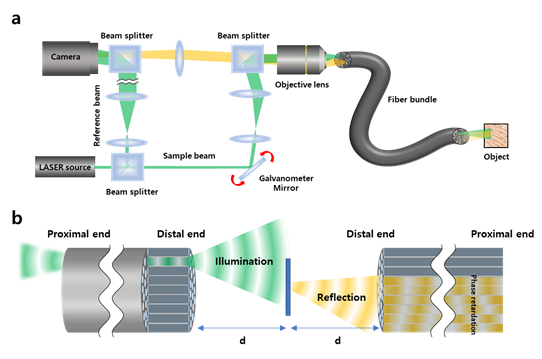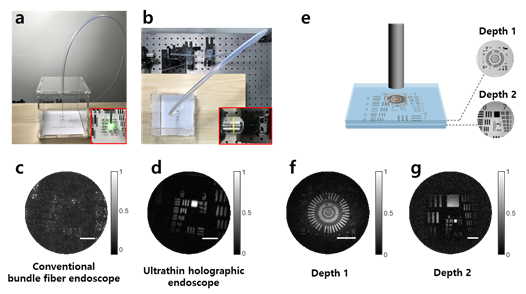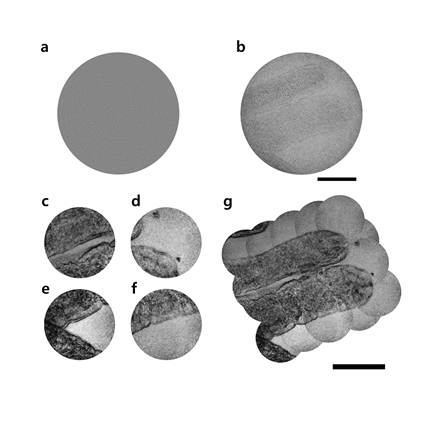|
The invention of a flexible ultra-thin endoscope
thinner than a needle - New
improvements in endoscopy technology allow for microscopic imaging of tissues
with minimal complications - |
Release
summary:
A research team led by CHOI Wonshik, the Associate Director
of the Center for Molecular Spectroscopy and Dynamics (CMSD) within the
Institute for Basic Science (IBS), has developed a high-resolution holographic
endoscope system thinner than an injection needle for microscopic imaging
inside a curved passage.
Full text
of release:
If
you are used to getting regular health checkups, you might be familiar with
endoscopes. The endoscope is an imaging device consisting of a camera and a
light guide attached to a long flexible tube. It is particularly useful for acquiring
images of the inside of a human body. For example, stomach and colon endoscopy
are widely used for the early detection and diagnosis of diseases such as
ulcers and cancers.
In
general, an endoscope is manufactured by attaching a camera sensor to the end
of a probe or using an optical fiber, which allows for information to be transmitted
using light. In the case of an endoscope that uses a camera sensor, the
thickness of the probe increases which makes the endoscopy rather invasive. In the
case of an endoscope using an optical fiber bundle, it can be manufactured in a
thinner form factor, which minimizes invasiveness and results in much less
discomfort to the patients.
However,
the downside is that in a conventional fiber-bundle
endoscope,
it is difficult to perform high-resolution imaging, because the resolution of the
obtained image is limited by the size of the individual fiber cores.
Much of the image information is also lost due to reflection from the probe
tip. Furthermore,
in fiber endoscopy, it is often necessary to label the target with fluorescence,
especially in biological samples with low reflectivity, due to strong
back-reflection noise generated from the tip of the thin probe.
Recently,
a research team led by CHOI Wonshik, the Associate Director
of the Center for Molecular Spectroscopy and Dynamics (CMSD) within the
Institute for Basic Science (IBS), has developed a high-resolution holographic
endoscope system. The
researchers were able to overcome the previous limitation of fiber optic
endoscopy and were able to reconstruct high-resolution images, without
attaching a lens or any equipment to the distal end of the fiber bundle.
This
feat was accomplished by measuring the holographic images of the light waves
that are reflected from the object and captured by the fiber bundle. The
researchers first illuminated an object by focusing light onto a single core of
a fiber bundle and measured holographic images that were reflected from the
object at a certain distance from the optical fiber. In the process of
analyzing the holographic images, it was possible to reconstruct the object
image with a microscopic resolution by correcting the phase retardation that
occurs by each fiber core. Specifically, a unique coherent image optimization algorithm
was developed to eliminate fiber-induced phase retardations in both the
illumination and detection pathways and reconstruct an object image with a
microscopic resolution.
Since
the developed endoscope does not attach any equipment to the end of the optical
fiber, the diameter of the endoscope probe is 350 μm, which is thinner than the
needle used for hypodermic injection. Using this approach, researchers were
able to obtain high-resolution images with a spatial resolution of 850 nm,
which is far smaller than the core size of the optical fiber bundle.
The researchers went on to test the new Fourier holographic
endoscopy system to image the villi structure of mice. It was possible to acquire high
contrast image by effectively removing the back-reflection noise of the probe,
even in biological samples with very low reflectivity, such as rat villi. In
addition, post-processing of the measured holographic information made it possible
to reconstruct multi-depth 3D images from a single data set with a depth
resolution of 14 μm.
It is believed that the practical application of this new
endoscope will greatly improve the way we can image the internal structures of
our body in a minimally invasive manner, with little to no discomfort for
patients. It will also open the possibility of directly observing cavities as
small as microvessels and the smallest airways in the lungs, which was
impossible with preexisting technologies. The researchers even suggested the
application of their new endoscope can go well beyond the medical field, as it
can potentially be useful for industrial inspections of semiconductors and
microprocessors.
This work was published in Nature Communications on August
2, 2022.

Figure 1. Experimental setup of ultrathin holographic
endomicroscope. (a) The output beam from a laser is divided into sample and
reference beams. The sample beam is delivered to the sample through the fiber bundle.
The backscattering signal from the sample, indicated as yellow for clarity
although its wavelength is identical to the incident wave, is captured by the fiber
bundle and delivered to the camera. The reference beam generates an
interferogram together with the signal beam at the camera. (b) Image formation
principle. The angular spectrum of the sample is obtained under Fresnel
conditions by separating the distance between the object and the optical fiber.

Figure
2. Endomicroscopic imaging through a narrow and curved passage, and 3D imaging
capability. (a) and (b) show front and top views of the experimental
configuration, respectively. (c) and (d) show the conventional endoscopic image
and the reconstructed image with the newly developed endoscope, respectively.
Scale bars: 20 μm. (e) shows endoscopic imaging of stacked targets. Two
resolution targets were placed at two different depths, 1 and. Ground-truth
images of the targets in depths 1 and 2 taken by conventional brightfield
microscope were shown next to the schematic. (f) and (g) display endoscopic images
for the depths of 1 and 2, respectively, reconstructed using a single
reflection matrix recording.

Figure
3. Microscopic imaging of villi in a rat intestine. (a) shows conventional
reflectance endoscope image taken when the fiber bundle was in contact with the
villi. (b) shows transmission image obtained through the fiber bundle. The LED
illumination was sent from the villi to the fiber bundle. (c)-(f) display label-free
reflectance images obtained using the newly developed holographic endoscope. (g)
shows a reconstructed image of two villi by stitching multiple images taken
over a wide region of interest. The 350-μm-diameter fiber bundle was used for
image acquisition. Scale bar: 100 μm.
Notes for editors
- References
Choi,
W., Kang, M., Hong, J.H. et al. Flexible-type ultrathin holographic endoscope
for microscopic imaging of unstained biological tissues. Nature Communications
(2022). DOI: https://doi.org/10.1038/s41467-022-32114-5
- Media Contact
For
further information or to request media assistance, please contact Munkyu Kang (kmk615@korea.ac.kr) or Wonshik Choi (wonshik@korea.ac.kr) at the Center for Molecular
Spectroscopy and Dynamics, Institute for Basic Science (IBS) or William I. Suh at the IBS Public
Relations Team (willisuh@ibs.re.kr).
- About the Institute for Basic Science (IBS)
IBS was
founded in 2011 by the government of the Republic of Korea with the sole
purpose of driving forward the development of basic science in South Korea. IBS
has 4 research
institutes and 35 research centers as of August 2022. There are eleven physics, three mathematics, seven chemistry, nine life science, two earth science, and three interdisciplinary research
centers.